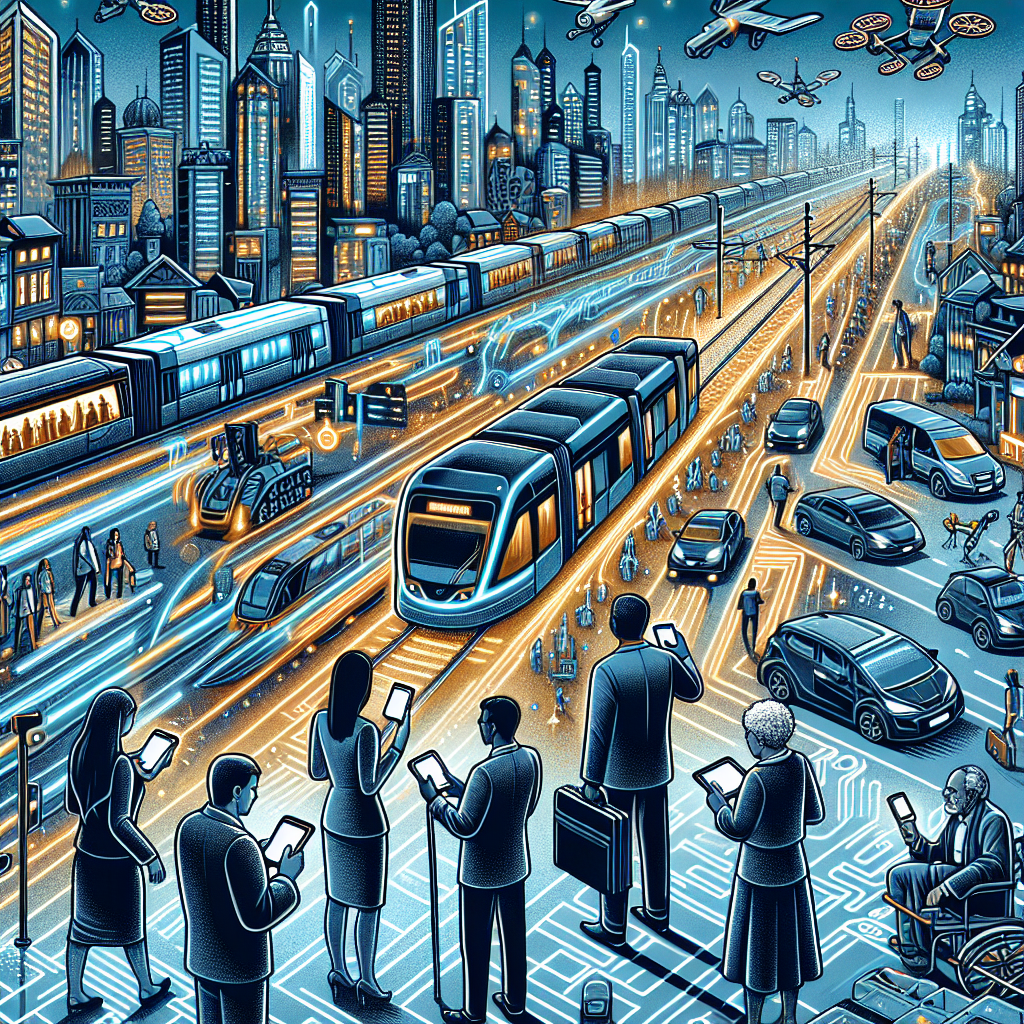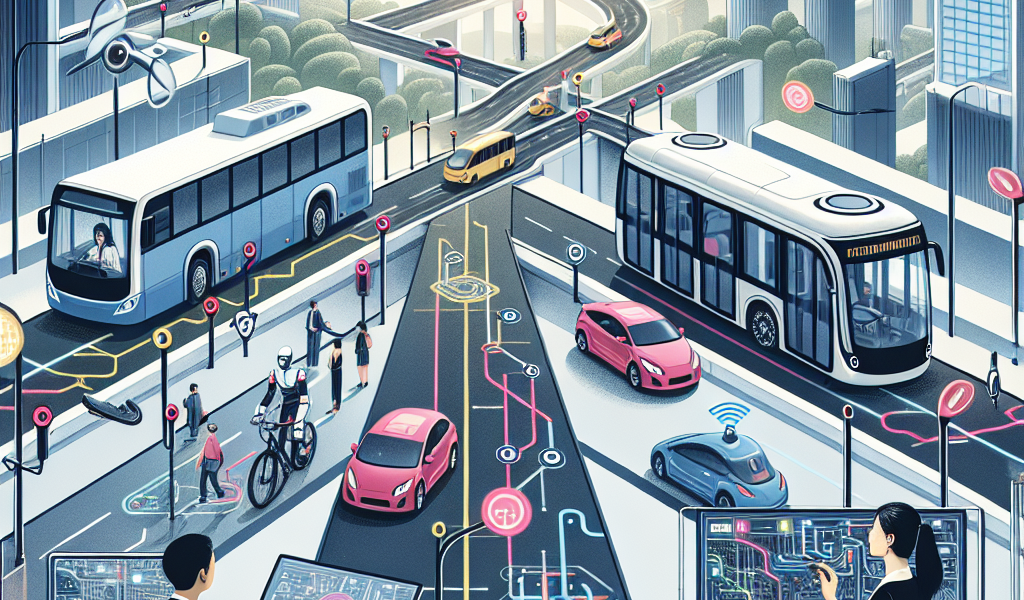-
Table of Contents
“Driving Innovation: How Technology Transforms Public Transportation for a Smarter, Greener Future”
Introduction

The Role of Technology in Enhancing Public Transportation
In recent years, the integration of advanced technology into public transportation systems has revolutionized the way people commute, offering unprecedented improvements in efficiency, safety, and user experience. From real-time tracking and data analytics to the implementation of smart infrastructure and autonomous vehicles, technology has become a pivotal force in addressing the challenges faced by urban transit networks. These innovations not only streamline operations and reduce costs but also contribute to environmental sustainability by promoting the use of public transit over private vehicles. As cities continue to grow and the demand for reliable and efficient transportation increases, the role of technology in enhancing public transportation becomes ever more critical, paving the way for smarter, more connected urban mobility solutions.
Smart Ticketing Systems: Revolutionizing Public Transit Efficiency
In recent years, the integration of technology into public transportation has significantly transformed the way people commute. One of the most notable advancements in this domain is the advent of smart ticketing systems, which have revolutionized public transit efficiency. These systems, which utilize digital platforms and contactless payment methods, have not only streamlined the ticketing process but also enhanced the overall passenger experience.
To begin with, smart ticketing systems have simplified the process of purchasing and validating tickets. Gone are the days when commuters had to stand in long queues to buy paper tickets or struggle with exact change for bus fares. With the introduction of contactless cards, mobile apps, and QR codes, passengers can now purchase tickets with just a tap or a scan. This convenience has made public transportation more accessible and user-friendly, encouraging more people to opt for buses, trains, and trams over private vehicles.
Moreover, smart ticketing systems have significantly reduced the operational costs for transit authorities. Traditional ticketing methods often required extensive manpower for sales, validation, and inspection. In contrast, digital systems automate these processes, allowing transit agencies to allocate resources more efficiently. This reduction in operational costs can be redirected towards improving other aspects of public transportation, such as maintenance, infrastructure, and service frequency.
In addition to cost savings, smart ticketing systems provide valuable data that can be used to optimize transit services. By analyzing travel patterns, peak usage times, and passenger demographics, transit authorities can make informed decisions about route planning, scheduling, and resource allocation. This data-driven approach ensures that public transportation services are more responsive to the needs of the community, ultimately leading to a more efficient and reliable transit system.
Furthermore, the implementation of smart ticketing systems has enhanced the security and transparency of fare collection. Digital transactions are less prone to fraud and theft compared to cash-based systems. Additionally, the use of encrypted payment methods and secure servers ensures that passenger information is protected. This increased security fosters trust among commuters, making them more likely to use public transportation regularly.
Another significant benefit of smart ticketing systems is their positive environmental impact. The reduction in paper ticket usage leads to less waste and a smaller carbon footprint. Additionally, by making public transportation more convenient and efficient, these systems encourage a shift away from private car usage, which in turn reduces traffic congestion and lowers greenhouse gas emissions. This aligns with global efforts to combat climate change and promote sustainable urban development.
While the advantages of smart ticketing systems are evident, it is important to acknowledge the challenges that come with their implementation. For instance, the initial investment in technology infrastructure can be substantial. However, the long-term benefits, such as operational savings and increased ridership, often outweigh these initial costs. Additionally, ensuring that all segments of the population, including the elderly and those without access to digital devices, can use these systems is crucial. Transit authorities must provide alternative options and support to ensure inclusivity.
In conclusion, smart ticketing systems have undeniably revolutionized public transit efficiency by simplifying the ticketing process, reducing operational costs, providing valuable data, enhancing security, and promoting environmental sustainability. As technology continues to evolve, it is likely that these systems will become even more sophisticated, further improving the public transportation experience for commuters around the world.
Autonomous Vehicles: The Future of Public Transportation
As cities around the world grapple with increasing congestion and pollution, the role of technology in enhancing public transportation has never been more critical. One of the most promising advancements in this field is the development of autonomous vehicles. These self-driving marvels are poised to revolutionize the way we think about public transit, offering a glimpse into a future where efficiency, safety, and convenience are paramount.
Autonomous vehicles, or AVs, are equipped with sophisticated sensors, cameras, and artificial intelligence systems that allow them to navigate roads without human intervention. This technology has the potential to transform public transportation by reducing human error, which is a leading cause of accidents. Consequently, the implementation of AVs could lead to safer roads and fewer traffic-related fatalities. Moreover, these vehicles can operate around the clock, providing consistent and reliable service that is not subject to the limitations of human drivers.
In addition to safety, autonomous vehicles promise to enhance the efficiency of public transportation systems. Traditional buses and trains often run on fixed schedules, which can lead to inefficiencies such as empty seats during off-peak hours. AVs, on the other hand, can be deployed dynamically based on real-time demand. This means that during peak hours, more vehicles can be put into service, while during quieter times, fewer vehicles are needed. This flexibility can lead to more efficient use of resources and reduced operational costs.
Furthermore, the integration of autonomous vehicles into public transportation systems can significantly reduce congestion. By communicating with each other and with traffic management systems, AVs can optimize routes and travel times, minimizing delays and bottlenecks. This interconnected network of vehicles can also adapt to changing traffic conditions, ensuring a smoother flow of traffic and reducing the overall time spent on the road.
Another compelling advantage of autonomous vehicles is their potential to improve accessibility. For individuals with disabilities or those who are unable to drive, AVs can provide a newfound sense of independence. These vehicles can be designed to accommodate various needs, such as wheelchair access or audio-visual aids for the visually or hearing impaired. By making public transportation more inclusive, AVs can help bridge the gap for those who have traditionally been underserved by existing transit systems.
Moreover, the environmental benefits of autonomous vehicles cannot be overlooked. Many AVs are being developed as electric vehicles, which produce zero emissions. By replacing traditional gas-powered buses and cars with electric AVs, cities can significantly reduce their carbon footprint. This shift towards greener transportation options is crucial in the fight against climate change and can contribute to cleaner air and healthier urban environments.
Despite the numerous advantages, the widespread adoption of autonomous vehicles in public transportation is not without challenges. Regulatory hurdles, technological limitations, and public acceptance are all factors that need to be addressed. However, ongoing advancements in technology and increasing investment in research and development are paving the way for a future where AVs become an integral part of our daily commute.
In conclusion, autonomous vehicles hold immense potential to enhance public transportation by improving safety, efficiency, accessibility, and environmental sustainability. As technology continues to evolve, it is essential for policymakers, industry leaders, and the public to work together to overcome the challenges and embrace the opportunities presented by this transformative innovation. The future of public transportation is on the horizon, and autonomous vehicles are set to lead the way.
Real-Time Data Analytics: Improving Public Transit Operations and Passenger Experience
In recent years, the integration of technology into public transportation systems has revolutionized the way cities manage transit operations and how passengers experience their daily commutes. One of the most significant advancements in this domain is the use of real-time data analytics. By harnessing the power of real-time data, transit authorities can optimize routes, reduce delays, and provide passengers with up-to-the-minute information, thereby enhancing the overall efficiency and appeal of public transportation.
To begin with, real-time data analytics allows transit operators to monitor and manage their fleets more effectively. By collecting data from GPS devices, sensors, and other tracking technologies installed on buses, trains, and other transit vehicles, operators can gain a comprehensive view of their network’s performance. This data can be analyzed to identify patterns, such as peak travel times and congestion points, enabling transit authorities to make informed decisions about route adjustments and scheduling. For instance, if a particular bus route consistently experiences delays during rush hour, operators can deploy additional buses or adjust the timing of services to alleviate congestion and improve punctuality.
Moreover, real-time data analytics plays a crucial role in predictive maintenance, which is essential for minimizing downtime and ensuring the reliability of transit services. By continuously monitoring the condition of vehicles and infrastructure, transit authorities can predict when maintenance is needed and address potential issues before they lead to breakdowns or service interruptions. This proactive approach not only enhances the safety and reliability of public transportation but also reduces maintenance costs and extends the lifespan of transit assets.
In addition to improving operational efficiency, real-time data analytics significantly enhances the passenger experience. One of the most notable benefits is the provision of real-time information to commuters. Through mobile apps, digital displays at transit stations, and other communication channels, passengers can access real-time updates on arrival and departure times, service disruptions, and alternative routes. This information empowers commuters to make informed decisions about their travel plans, reducing uncertainty and stress associated with delays and unexpected changes.
Furthermore, real-time data analytics enables personalized travel experiences. By analyzing data on individual travel patterns and preferences, transit authorities can offer tailored recommendations and services to passengers. For example, a commuter who frequently travels on a specific route during peak hours might receive notifications about less crowded alternatives or suggestions for off-peak travel to avoid congestion. This level of personalization not only enhances convenience but also encourages greater use of public transportation by making it more user-friendly and responsive to individual needs.
Another significant advantage of real-time data analytics is its potential to improve accessibility and inclusivity in public transportation. By analyzing data on the usage patterns of different demographic groups, transit authorities can identify gaps in service and implement measures to address them. For instance, if data reveals that certain neighborhoods with high populations of elderly or disabled residents have limited access to transit services, authorities can prioritize the deployment of accessible vehicles and infrastructure improvements in those areas. This ensures that public transportation is equitable and serves the needs of all community members.
In conclusion, the integration of real-time data analytics into public transportation systems has brought about transformative changes in both operational efficiency and passenger experience. By leveraging real-time data, transit authorities can optimize routes, enhance reliability, provide timely information, and offer personalized services, ultimately making public transportation a more attractive and viable option for commuters. As technology continues to evolve, the potential for further improvements in public transit operations and passenger satisfaction is boundless, promising a future where public transportation is not only efficient but also seamlessly integrated into the fabric of urban life.
Conclusion
The role of technology in enhancing public transportation is multifaceted, encompassing improvements in efficiency, safety, accessibility, and user experience. Advanced technologies such as real-time tracking, automated fare collection, and predictive maintenance have streamlined operations and reduced costs. Additionally, the integration of mobile applications and digital platforms has made it easier for passengers to plan trips, receive updates, and make payments. Innovations like electric and autonomous vehicles are also contributing to more sustainable and reliable transit systems. Overall, technology is pivotal in transforming public transportation into a more efficient, user-friendly, and environmentally friendly mode of travel.





